Introduction by Dr Phill Pullinger, Kuno Director and CEO:
I don’t know if I’ve mentioned it to her before, but I think of Tonia as Australia’s Rachel Carson. She’s absolutely extraordinary, as you’ll soon find out if you haven’t met Tonya already. She’s an extraordinary person. Tonia grew up in the suburbs of Melbourne, but from the earliest age was fascinated by Nature. She drove her parents crazy raising pet redback spiders at home and pet frogs and baby possum and grew up just absolutely fascinated by the Natural world.
She studied marine biology at university, which took her on new adventures to Macquarie Island and Antarctica. But she found her home on Bruny and has founded in Inala in my opinion, one of the world’s most inspiring conservation-focused Nature tourism companies. So Tonya is going to talk to us a bit about what makes Bruny Island ecology extraordinary. Thanks Tonia.
--
Dr Tonia Cochran: I would just reiterate that Bruny Island is a microcosm of Tasmania. It includes most of our vegetation types – rainforest, coastal vegetation, wet sclerophyll, dry woodland grasslands – pretty much everything except a true alpine environment.
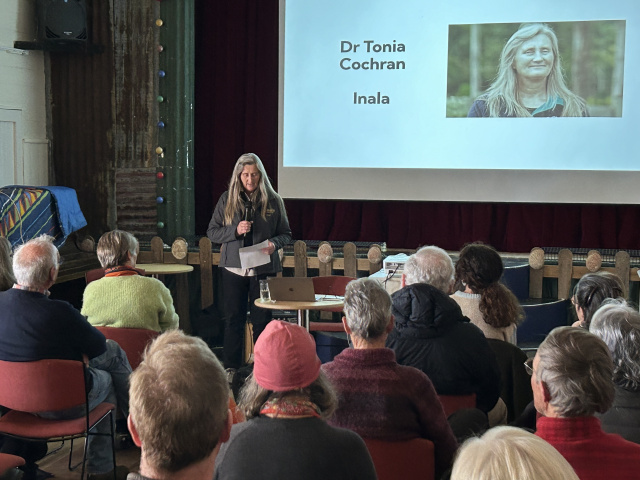
It’s very unusual for an island to have everything in one go. If you think of other islands like Kangaroo Island or King Island, they’re generally much the same vegetation type. We have a bit of everything and that’s special.
Our fresh water is some of the cleanest in the world. It filters over abut 13 thousand kilometres at sea, because the Neck’s landfall to the west is south America. It misses south Africa altogether. So you’ve got all that filtering before it reaches Tasmania. We have the cleanest water in the world. Who else could say that?
The island’s reasonably large – it’s over 360 kilometres square – about 50km long and various widths as we know. It’s basically two bits joined together by what’s called a tombolo, which is a little sand isthmus in between. That size allows it to have quite a variety of wildlife, birds and animals and plants on it.
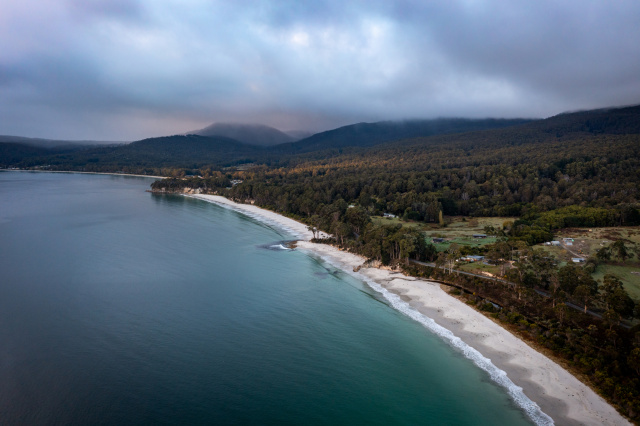
Bruny Island has an oceanic climate – it’s not too hot and it’s not too cold, so we’re in a Goldilocks zone. How cool’s that?
We have incredibly high Natural values and huge expanses of habitat that have been minimally disturbed. And many of the locals here actively manage to increase the Natural habitat. We’re isolated – we’re an island off an island off an island, as you’ll hear a lot of people say. And that forms a lot of barriers that protect us from things like disease.
With our remoteness, we’ve managed to avoid the development of most other places. We’ve got a grand total – depending on who you listen to – of 600 to 800 permanent residents, and access is restricted by the ferry, or whoever’s going to paddle backwards and forwards on their boats.
All of the above make it a stronghold for wildlife and a refuge for a plethora of threatened species. Many of them are only found in Tasmania, so they’re endemic to Tasmania.
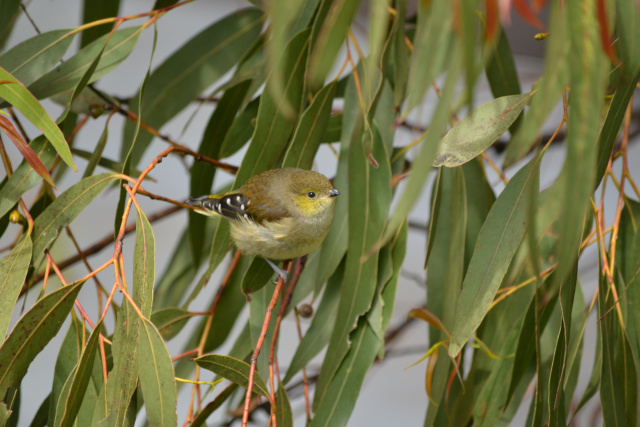
Two of those are our signature species – the forty-spotted pardalote and the swift parrot. The forty-spot, as you probably know, are endangered and they’re endemic to Tasmania. And over half of that population of species is just found on Bruny Island. The other half is found on Maria Island, which is also an island and a national park.
The swift parrot is now critically endangered, and the stats say that between only as few as 300, and 800, are left. And that’s on a path to spiraling to extinction. The modeling shows it may not even be with us within the next 20 years, which is terrifying.
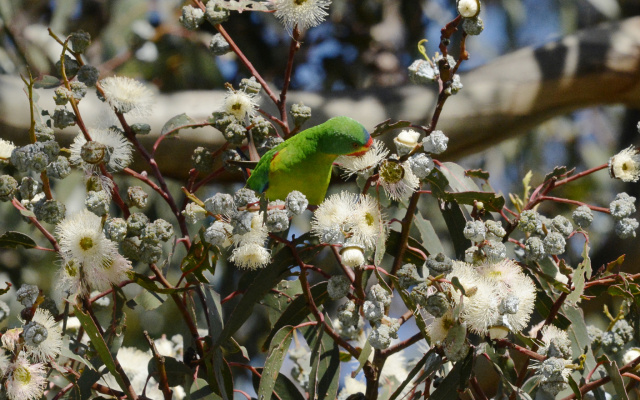
They migrate to Tassie to breed, and they get hammered by sugar gliders, or Krefft’s gliders as we call them today. When they came to Tasmania, they’re a native species that has been released to the wild and is now wreaking havoc.
Bruny Island doesn’t have gliders, so when the swift parrots breed here they have a much higher chance of survival.
It’s a stronghold for another threatened species – wedge tailed eagles. There are several pairs on Bruny. They’re on the endangered list here in Tasmania. There’s less than a thousand individuals in Tasmania and we have several of them. I think all of you here have probably seen wedge tails quite frequently. That’s very unusual.
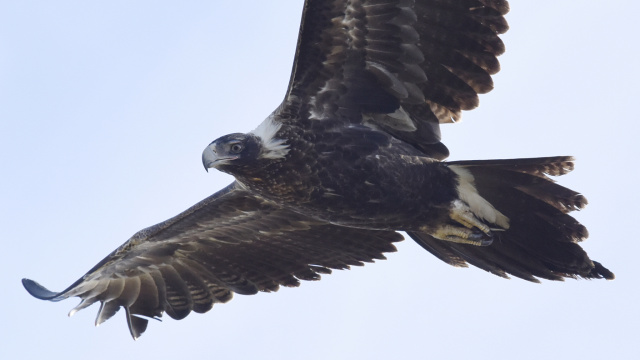
Grey goshawks – that beautiful pure white bird of prey. Less than 110 breeding pairs throughout the state and again, several on Bruny.
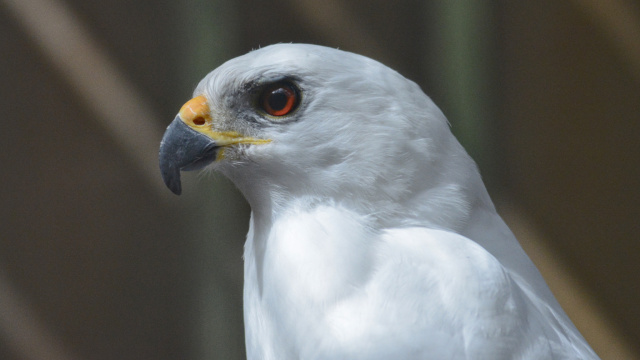
The eastern quoll’s now on the endangered list. The population has declined by 50% in the last ten years and the remaining stronghold is on Bruny Island.
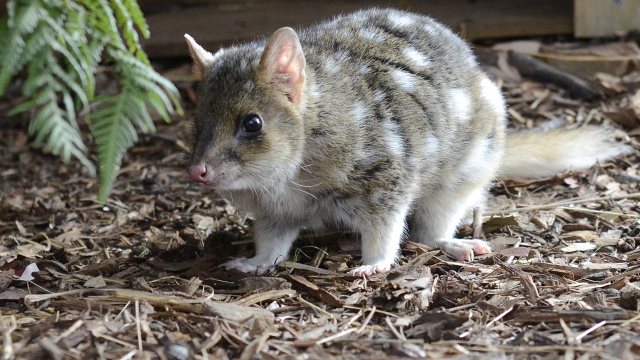
We have all 12 endemics and more than 150 species of birds recorded here. We have almost 80% of the total 50-ish land and sea-based mammals in Tasmania. I’ve personally seen wombat burrow photos when I’ve done consulting work on the island and the early records show that there was even devils here when white settlers first came here.
We have a number of threatened plants, including the shy eyebright and the chestnut leek orchid, among others. Bush Blitz came here in 2016 and on their website they say: a bush blitz was conducted on Bruny Island in Tasmania.
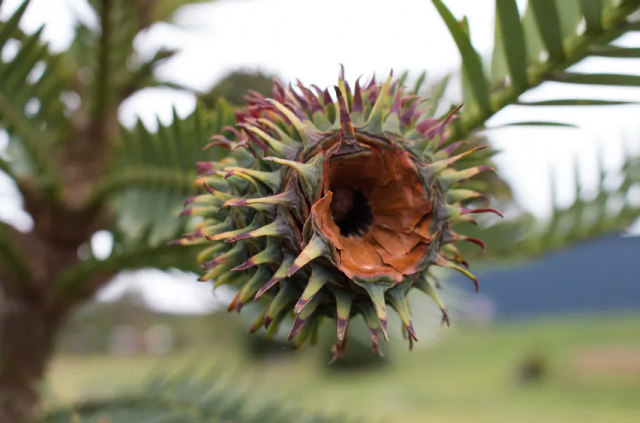
Sites recorded 848 species, at least 591 of which previously have not been recorded and 63 were new to science. They did the insects and all. One threatened animal species, 30 exotic or pest animal species and one exotic seaweed species was recorded. 10 seed collections were made, 10 taxa totalling 816,700 seeds that they’ve now stored in perpetuity.
So it’s a pretty amazing place, and new species are still being discovered here. It’s one of the few wild places left in the world.
This through our active remediation, through a large amount of tree planting that we’re doing on Bruny at the moment, gives these species a real chance.

It’s so much harder to fix something once it’s broken. This isn’t broken.
The island’s on the spotlight now – it’s the flavour of the month with visitors. The tourism industry is becoming an important income-earner for Bruny. I’m in it myself, and Inala employs 14 Bruny Islanders, apart from a number of interstate and other Tassie people. It brings wealth to the community – accommodation, food, providers, tour operators and such – we need tourism, responsible tour operators.
But we need people who take only photos and leave only footsteps. We need people who value our special island and its inhabitants, and that includes us too. We need to be careful of too much of a good thing.
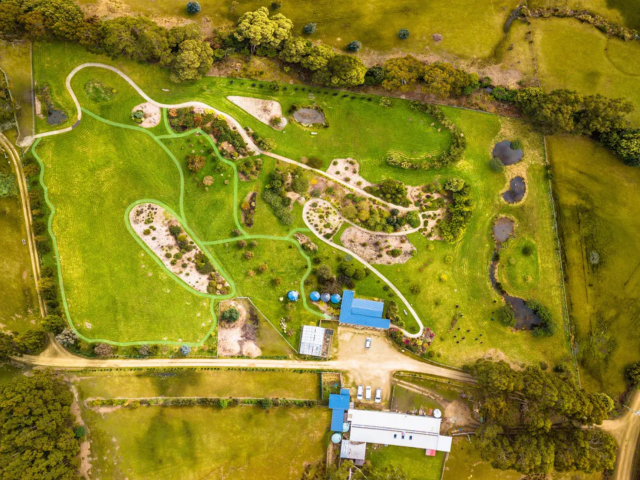
Inala’s proud to partner with BIEN (Bruny Island Environment Network) and Kuno on this exciting project, and we know that this will increase awareness of our special island and its amazing flora and fauna.
I travel widely to some of the most remote areas of the world and see amazing plants and animals – that’s part of my job. The more I travel the more special I realise Bruny is. I’ve been a resident for over 37 years now, and nothing on this earth is going to make me move.
Bruny Islanders are some of the richest people in the world. Not in terms of money, but in terms of quality of life, of clean air and water and of an intact Natural environment. That’s incredibly rare in the world these days, and let’s not bugger that up.
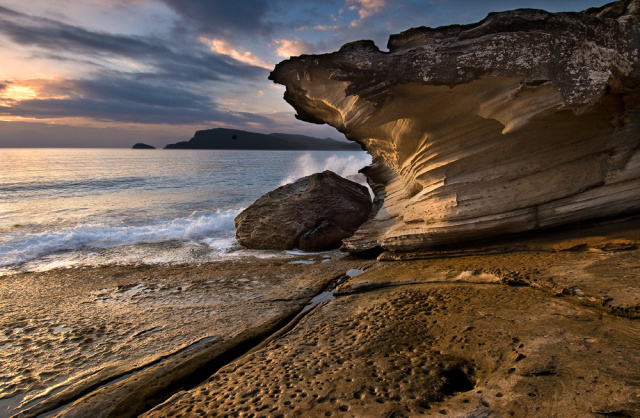
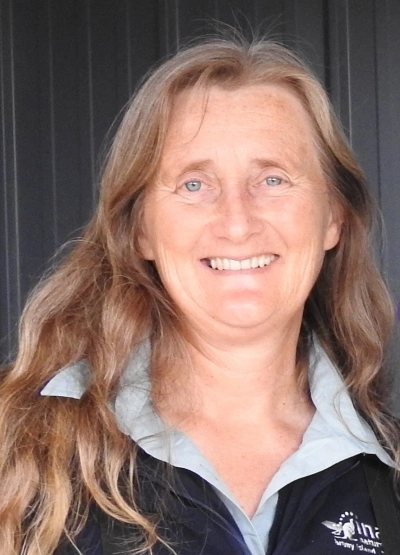
Dr Tonia Cochran
Introduction by Dr Phill Pullinger, Kuno Director and CEO:
I don’t know if I’ve mentioned it to her before, but I think of Tonia as Australia’s Rachel Carson. She’s absolutely extraordinary, as you’ll soon find out if you haven’t met Tonya already. She’s an extraordinary person. Tonia grew up in the suburbs of Melbourne, but from the earliest age was fascinated by Nature. She drove her parents crazy raising pet redback spiders at home and pet frogs and baby possum and grew up just absolutely fascinated by the Natural world.
She studied marine biology at university, which took her on new adventures to Macquarie Island and Antarctica. But she found her home on Bruny and has founded in Inala in my opinion, one of the world’s most inspiring conservation-focused Nature tourism companies. So Tonya is going to talk to us a bit about what makes Bruny Island ecology extraordinary. Thanks Tonia.
--
Dr Tonia Cochran: I would just reiterate that Bruny Island is a microcosm of Tasmania. It includes most of our vegetation types – rainforest, coastal vegetation, wet sclerophyll, dry woodland grasslands – pretty much everything except a true alpine environment.

It’s very unusual for an island to have everything in one go. If you think of other islands like Kangaroo Island or King Island, they’re generally much the same vegetation type. We have a bit of everything and that’s special.
Our fresh water is some of the cleanest in the world. It filters over abut 13 thousand kilometres at sea, because the Neck’s landfall to the west is south America. It misses south Africa altogether. So you’ve got all that filtering before it reaches Tasmania. We have the cleanest water in the world. Who else could say that?
The island’s reasonably large – it’s over 360 kilometres square – about 50km long and various widths as we know. It’s basically two bits joined together by what’s called a tombolo, which is a little sand isthmus in between. That size allows it to have quite a variety of wildlife, birds and animals and plants on it.

Bruny Island has an oceanic climate – it’s not too hot and it’s not too cold, so we’re in a Goldilocks zone. How cool’s that?
We have incredibly high Natural values and huge expanses of habitat that have been minimally disturbed. And many of the locals here actively manage to increase the Natural habitat. We’re isolated – we’re an island off an island off an island, as you’ll hear a lot of people say. And that forms a lot of barriers that protect us from things like disease.
With our remoteness, we’ve managed to avoid the development of most other places. We’ve got a grand total – depending on who you listen to – of 600 to 800 permanent residents, and access is restricted by the ferry, or whoever’s going to paddle backwards and forwards on their boats.
All of the above make it a stronghold for wildlife and a refuge for a plethora of threatened species. Many of them are only found in Tasmania, so they’re endemic to Tasmania.

Two of those are our signature species – the forty-spotted pardalote and the swift parrot. The forty-spot, as you probably know, are endangered and they’re endemic to Tasmania. And over half of that population of species is just found on Bruny Island. The other half is found on Maria Island, which is also an island and a national park.
The swift parrot is now critically endangered, and the stats say that between only as few as 300, and 800, are left. And that’s on a path to spiraling to extinction. The modeling shows it may not even be with us within the next 20 years, which is terrifying.

They migrate to Tassie to breed, and they get hammered by sugar gliders, or Krefft’s gliders as we call them today. When they came to Tasmania, they’re a native species that has been released to the wild and is now wreaking havoc.
Bruny Island doesn’t have gliders, so when the swift parrots breed here they have a much higher chance of survival.
It’s a stronghold for another threatened species – wedge tailed eagles. There are several pairs on Bruny. They’re on the endangered list here in Tasmania. There’s less than a thousand individuals in Tasmania and we have several of them. I think all of you here have probably seen wedge tails quite frequently. That’s very unusual.

Grey goshawks – that beautiful pure white bird of prey. Less than 110 breeding pairs throughout the state and again, several on Bruny.

The eastern quoll’s now on the endangered list. The population has declined by 50% in the last ten years and the remaining stronghold is on Bruny Island.

We have all 12 endemics and more than 150 species of birds recorded here. We have almost 80% of the total 50-ish land and sea-based mammals in Tasmania. I’ve personally seen wombat burrow photos when I’ve done consulting work on the island and the early records show that there was even devils here when white settlers first came here.
We have a number of threatened plants, including the shy eyebright and the chestnut leek orchid, among others. Bush Blitz came here in 2016 and on their website they say: a bush blitz was conducted on Bruny Island in Tasmania.

Sites recorded 848 species, at least 591 of which previously have not been recorded and 63 were new to science. They did the insects and all. One threatened animal species, 30 exotic or pest animal species and one exotic seaweed species was recorded. 10 seed collections were made, 10 taxa totalling 816,700 seeds that they’ve now stored in perpetuity.
So it’s a pretty amazing place, and new species are still being discovered here. It’s one of the few wild places left in the world.
This through our active remediation, through a large amount of tree planting that we’re doing on Bruny at the moment, gives these species a real chance.

It’s so much harder to fix something once it’s broken. This isn’t broken.
The island’s on the spotlight now – it’s the flavour of the month with visitors. The tourism industry is becoming an important income-earner for Bruny. I’m in it myself, and Inala employs 14 Bruny Islanders, apart from a number of interstate and other Tassie people. It brings wealth to the community – accommodation, food, providers, tour operators and such – we need tourism, responsible tour operators.
But we need people who take only photos and leave only footsteps. We need people who value our special island and its inhabitants, and that includes us too. We need to be careful of too much of a good thing.

Inala’s proud to partner with BIEN (Bruny Island Environment Network) and Kuno on this exciting project, and we know that this will increase awareness of our special island and its amazing flora and fauna.
I travel widely to some of the most remote areas of the world and see amazing plants and animals – that’s part of my job. The more I travel the more special I realise Bruny is. I’ve been a resident for over 37 years now, and nothing on this earth is going to make me move.
Bruny Islanders are some of the richest people in the world. Not in terms of money, but in terms of quality of life, of clean air and water and of an intact Natural environment. That’s incredibly rare in the world these days, and let’s not bugger that up.

You might like...

Bruny Island launch: CEO Phill Pullinger on the Kuno concept

Bruny Island - lunawanna-alonnah field guide

Inala Jurassic Garden's Noah's Ark project

Kew Gardens and Inala team up for ancient Gondwanic species
Newsletter
Sign up to keep in touch with articles, updates, events or news from Kuno, your platform for nature
